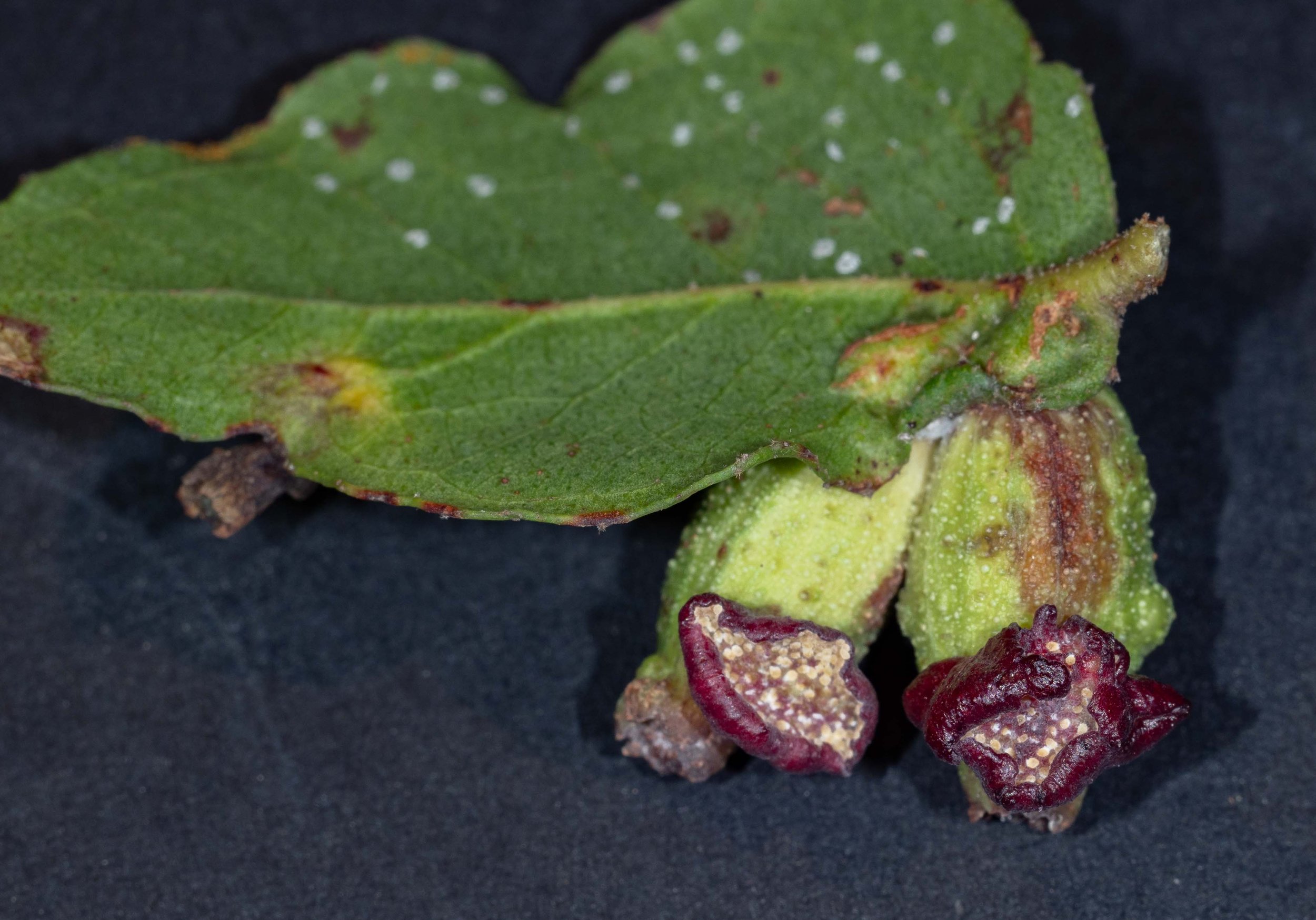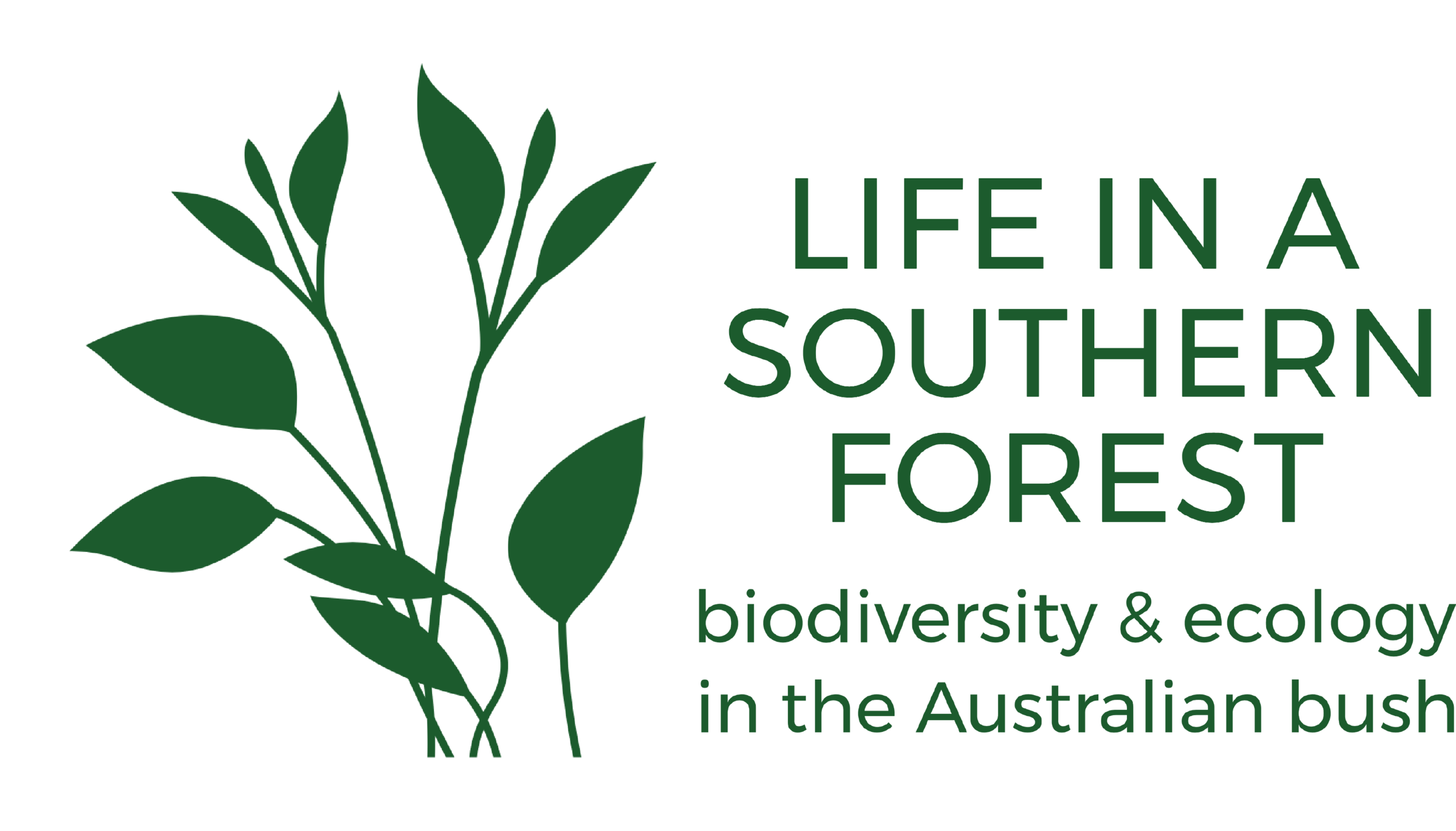Apiomorpha pharetrata male gall early development

Male compound gall on female Apiomorpha pharetrata gall
21st November, 2024
Today I sighted the first male compound gall growing on a female Apiomorpha pharetrata gall. There were around 30 individual male galls in this cluster. They did not have the regular columnar arrangement see in the mature male compound galls, but white patches showed where the developing male insects inside were probably excreting their honeydew. This was on a leaf of a eucalypt sapling on home trail, on right before Orchid Track.
Ants were clambering around the galls, ready to collect honeydew from the open, wax-covered pore of the female gall.
20th December
Female gall is dark brown, although still wax at pore and ants still gathering honeydew. Clear separation between male galls, some of which have green sides.
Dissection of an early male compound gall
16th December, 2024
Single female gall with early male compound gall collected from same bush as in the following analysis of early stages. Surface of male gall is shown in series of high magnification images below.
Thin vertical slices were progressively cut from one side of the male compound gall, exposing galleries of male coccid nymphs.
1st slice exposes a 2nd instar nymph in a gallery about halfway down the gall
2nd slice exposes a wasp or fly larva in a cavity halfway down the gall
3rd slice exposes an exuvia of a crawler in a gallery at the top of the gall
4th slice - exposes a 3rd instar nymph at bottom of a vertical gallery
5th slice exposes a 2nd instar nymph in a gallery towards the top of the gall
6th slice exposes a 2nd instar nymph in a gallery
7th slice exposes a 3rd instar nymph in a gallery towards the bottom of the gall
movement of nymph within its gallery
8th slice reveals a 1st instar stage nymph (crawler) in a gallery towards the top of the gall
A further series of consecutive slices through the male gall reveals the arrangement of galleries with their nymphal occupants.
Early stages in formation of the compound male gall of Apiomorpha pharetrata
21st November, 2024
Two galls found close to one another on a leaf of a eucalypt sapling on home trail, on right before Orchid Track.
Both have an active female in the female gall as seen by movement and wax around apical pore. Each has a reddish cup shaped structure attached close to the apical end.
Inside the cup are hundreds of yellow crawlers. These are immobile, attached to the inside surface of the cup. However some were seen moving around the rim of the cup.
There is no sign of formation of individual male galls within the cup at this time.
This video shows the female gall bug protruding her anal lobes from the pore at the end of her gall chamber. It then moves to the compound male gall which is developing on the surface of her gall. The inner surface of that gall is covered in first instar nymphs - “crawlers”.
I found some earlier developing male galls on female galls on a eucalypt sapling on home trail, just after Orchid trail on left, adjacent to a killed Acacia obtusifolia bush.
Gall marked with light blue wool
22nd November, 2024
Dark red male gall at apical end of female gall. Elevated sides which are turned over at top, obscuring inner face, but it is clear that crawlers are inside. The pore on the female gall has wax around it so is apparently active. An ant seeking honey dew supports that.
23rd November, am
Gall hasn’t changed much from day before.
24th November
25th November
14th December
Compound male gall has now expanded to a wide platform with a flat surface. It is made up of many individual galls fused together.
15th December
Little change from previous day
18th December
no apparent change in size of male gall
20th December
little change
29th December, 2024
Little change to previous record
7th January, 2025
some extra galls have been added to the periphery
14th January, 2025
stem of branch leading to gall has snapped, branch hanging down. the branch with gall removed and imaged in lab
15th January
I made a series of vertical slices through the male gall, starting from the lateral edge. I removed the nymphs in the opened cells and imaged them.
Slice #1 through lateral edge of gall
A 2nd instar nymph found in one cell (seen below) and younger ones in others
Slice #2
4th to 5th instar nymphs found in these cells
Slice #3
a final instar nymph found in one of the central cells in this slice
Slice #4
4th instar nymph in a central cell (marked with arrow in cross section image), younger than that shown in slice #3
Slice #5
5th instar nymph found, eyes just starting to pigment
Slice #6
5th instar nymph found a couple of cells away from edge of gall (arrowed)
Slice #7
final stage nymph found in cell close to middle of gall
I continued making vertical slices through this gall. After making each slice, I removed nymphs that had been exposed, imaged them and marked their location using coloured dots according to nymphal stage. The image below shows the positions of the nymphs.
When the first 7 slices shown above were made, only one or two nymphs in each slice were imaged and staged (hence the regions on the left of the gall lacking coloured dots) and their positions within the gall were not accurately recorded.
Numbers of nymphs of each instar are indicated below:
Alate adults - 6
Instar #5 - 47
Instar #4 - 10
Instar #3 - 8
Instar #2 - 8
Instar #1 - 13
undetermined stage - 18
There was no sign of any parasites in the male galls and all except for around a dozen nymphs were living.
The female was removed from her gall and fixed. She was healthy and had many crawlers - over 65 - inside her gall.
Gall marked with green wool
22nd November, 2024
The female gall has a small female gall attached at its basal end. A raised dark red area at the apical end, close to the apical pore has ~14 crawlers on its surface. This appears to be the earliest stage of male gall development.
23rd November morning
Looks much the same as day before - perhaps a few more crawlers on the incipient gall, which hasn’t changed much. A drop of honeydew has collected at the pore of the female gall.
24th November
Clearly more crawlers on surface of the gall than on previous day. Sides of gall are somewhat higher.
25th November
Yet more crawlers have arrived and now form more than one layer over its inner surface. Sides of the gall have continued to grow upwards.
14th December
Male compound gall has now grown markedly. Its sides are elevated and are curved inwards. The inner surface lies beneath the upper edge and is rough. Individual male galls cannot be seen clearly but white patches are likely to be sites where individual male excrete their honeydew. No free crawlers can be seen on its surface.
15th December
Little change from previous day, but a couple of crawlers seen on upper surface of the gall
18th December
Some lateral growth near pointed region. A crawler seen at base of male gall, apparently having just left female gall
20th December
A couple of new crawlers on the surface of the male gall, but otherwise no apparent change.
29th December
Male gall has a more even border. Crawlers seen on the outer edge of the gall.
7th January
little apparent change in male gall
14th January
30th January
7th February
17th February
27th February
4th March
8th March - final photos of gall in situ. Branch cut from sapling at 11:00am to begin slicing through male gall.
Change in male gall over 28 day period
I made a series of parallel vertical slices through the male gall to expose the contents of the cells.
A living alate male was found in only one cell, indicated by the red arrow.
Most of the cells were empty, presumably because the nymphs inside had developed to the adult stage and departed.
A substantial number of cells had dead alate males inside.
Living larvae - possibly of a wasp - were found in a few cells, two of which are indicated by yellow arrows. It is likely that at least some of the males were killed by these parasitic larvae.
A dead adult wasp was found in two cells, one in the position indicated by the green arrow. Parasitic mites were found attached to this wasp, like that seen in my previous post - a Pyemotes sp.
Photos of the various creatures found in the male gall chambers are shown in the panel below.
The female bug was still active as shown by the wax deposits around the apical pore, the presence of an ant seeking secreted her honeydew and her projecting anal lobes (see first photo in panel below.
I opened the female gall by making a horizontal slice through its surface to reveal the female bug. She responded immediately to touch. Many crawlers (around 60) were present inside her gall chamber, actively crawling around its walls.
Photos of the female bug and her crawlers are shown below.
Gall marked with purple wool
Another gall on same sapling. This one has a cleft across it and many crawlers have gathered on its lips and inside. There are other smaller dark red areas alongside which may also become part of the male gall.
23rd November, 2024
24th November, 2024
25th November
14th December
Compound male gall has enlarged somewhat. Crawlers are no longer evident on its surface. The upper side is flat and consists of several individual galls fused together. A single crawler is present on the side of the male gall.
15th December
Little change to previous day. Upper surface of gall has regularly spaced white, waxy patches which are the openings of the individual male galls.
18th December
a little growth of male gall?
20th December
clear lateral growth of the male gall since 18th.
29th December
borders more even
7th January 2025
male gall has grown
Gall marked with white wool
A dark red streak next to the pore of a female gall - beginnings of a male gall?
23rd November
24th November
25th November
14th December
No change in female gall. The dark brown streak on its surface has not developed further.
15th December
No further change. Wax at opening of female gall indicates a female still living inside.
18th December
no apparent change - no sign of male gall
19th December
no apparent change
29th December
no apparent change
7th January 2025
green bump has grown a little?
Gall marked with blue and dark green wool
19th December
Pronounced bump on female gall near pore. No sign of crawlers on its surface.
21st December
Bump appears higher, no sign of crawlers
29th December
no apparent change
7th January 2025
no apparent change






































































































































































































































































